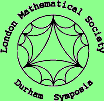 |
|
| Home | |
| Programme | |
| Short Courses | |
| Talks | |
| Posters | |
| For Presenters | |
| Participants | |
| Travel | |
| Recreation |
LMS Durham Symposium
Computational methods for wave propagation in direct scattering
Enru Liu (British Geological Survey. UK)
Multiple scattering of elastic waves in media with inclusions or cracks
Abstract
In this presentation we use a 2D elastodynamic boundary integral equation or boundary element method (BEM) to solve multiple scattering problems due to existence of cracks or inclusions. The method is based on the integral representation of a scattered wavefield by assuming a fictitious source distribution on the scattering objects or inclusions (i.e. mathematical description of Huygens$'$ principle), and the fictitious source distribution can be found by matching appropriate boundary conditions at the boundary of the inclusions. The method is called as indirect boundary element method. Three numerical examples are presented to demonstrate the versatility of the BEM method. The first example shows that different spatial arrangements of the same scatters lead to profound differences in scattering characteristics, in particular the frequency contents of the transmitted wavefields using the method of time-frequency analysis. The second example shows the effects of power-law or fractal distribution of scalelengths on transmitted wavefields, and we conclude that frequency characteristics, such as the frequency of the peak attenuation, can be related to spatial size parameters of the model. In the third example, we show that orientated inclusions with aspect ratio less than unity have strong effects on the amplitudes of transmitted waves, and this has an important implication in characterizing inclusions and fractures using azimuthal variation in amplitudes (or attenuation anisotropy).